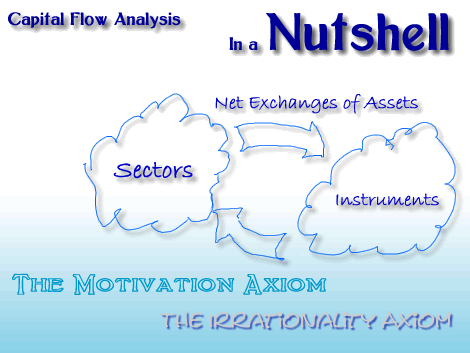Capital Flow Analysis in a Nutshell:
Basic Capital Flow Analysis

 Capital Flow Analysis Explained in Few Words
Capital Flow Analysis Explained in Few Words
Capital Flow Analysis in Plain Language
Capital Flow Analysis is a way of predicting price trends in securities markets.
The purpose is to forecast market conditions for broad classes of securities, such as stocks, bonds, and mortgages.
The focus is on major market movements, rather than short-term fluctuations.
Conceptualizing the Market
A capital market is made up of groups of players, called sectors, such as:
- Households,
- Non financial corporations,
- Commercial banks, and
- Insurance companies.
Each sector is different.
Each sector has rules, customs, and constraints.
The sectors exchange classes of financial instruments, according to their distinct rules, customs, and constraints.
Capital Flow Analysis uses statistics on the net exchange of assets between sectors to reach conclusions.
Sectors and Instruments
The sectors trade classes of instruments, such as:
- Corporate bonds,
- Corporate equities,
- Mutual funds, and
- Municipal bonds.
Capital flows are the net transfer of instruments between sectors, such as:
- Net sales of corporate bonds by households,
- Net purchases of equities by insurance companies,
- Net sales of municipal bonds by commercial banks, and
- Net purchases of mutual funds by households.
A market is made up of a dozen or so sectors, each exchanging categories of financial instruments, in varying amounts, with other sectors.
In Capital Flow Analysis, the focus is not on specific securities (General Motors bonds), but on broad categories of assets (corporate bonds).
The Concept of Motivation
The reason why there is a net flow of a certain class of financial instrument from one sector to another is called motivation.
Because each sector operates under different rules, customs, and constraints, the motivation that explains why one sector is buying certain types of assets is often different from the motivation of other sectors buying the same class of instruments.
In Capital Flow Analysis, we assume that some sectors are more motivated (that is, they have more reason) than others to buy or sell certain classes of financial assets.
Motivation and Price Trends
Capital Flow Analysis is based on a Motivation Axiom, which says that price trends are caused by one sector being more motivated than another regarding the purchase or sale of a particular type of instrument.
One objective of analysis is to discover the reason (motivation) that explains why a sector is buying or selling particular types of assets.
The Irrationality Axiom states that the reasons that sectors buy or sell particular classes of instruments do not always conform to expectations of rational behavior taught in Economics 101.
Over long periods, some sectors may sell assets below intrinsic value, while others may knowingly pay more for assets than they are worth.
Sometimes players act rationally, and sometimes not.
Explanations in History and Society
The motivation that causes sectors to buy or sell certain types of instruments is often related to long-term historical and social trends.
For example:
The position of the U.S. dollar as the premier international currency since the end of the gold standard in 1971, has resulted in a worldwide habit of accumulating savings in dollars.
This has led to an excess of imports over exports (the trade deficit) and in international players having an increasing amount of dollars to invest.
Foreign holders of dollars have long shown preference for fixed income investments over equities.
Therefore, the increasing volume of dollars held by foreigners has put upward pressure on bond prices.
The long up trend in U.S. bond prices since the 1980s is directly correlated to increasing foreign trade deficits.
Other things remaining the same, we would expect bond prices to continue to rise along with the trade deficit.
Therefore, the driving force behind the long-term rise in bond prices has been the desire of foreign exporters to sell goods to the U.S. in order to accumulate dollar assets.
The reasons why foreign exporters want to to accumulate dollars, even though dollar interest rates have been falling, are related to complex historical and societal trends throughout the world that have led to the dollar being viewed as a safe currency.
The Basis For Trend Prediction
Capital Flow Analysis is used to predict price trends in categories of instruments (not individual stocks or bonds).
Simply put, forecasting price trends for a class of financial instruments depends upon:
Predicting the continuity of patterns of net flows of instruments between sectors;
Predicting the persistence of the current motivation of sectors with regards to each instrument class.
For example, in predicting the price of corporate bonds, based on the above example, we would need to make predictions regarding:
- The U.S. trade deficit; and
- The preferences of the rest of the world for dollar assets.
Sources of Information
In the United States, information required for Capital Flow Analysis comes from national flow of funds accounts published quarterly by the Federal Reserve Bank Board of Governors.
Information regarding the motivation of sectors comes from research on the Internet and reading.
Access to this information can be found on this site.